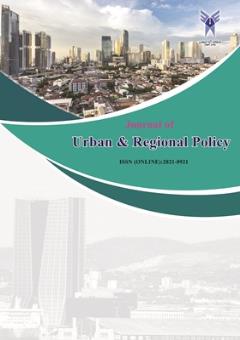Promotion policy of creative architecture design process
Subject Areas : Urbanism
Mohammad hossein Eslampour
1
![]() ,
nima valizadeh
2
*
,
nima valizadeh
2
*
![]() ,
Shabnam Akbari Namdar
3
,
Shabnam Akbari Namdar
3
1 - Student
2 - Department of Architecture, Tabriz Branch, Islamic Azad University, Tabriz, Iran.
3 - Assistant Professor, Department of Architecture, Tabriz Branch, Islamic Azad University, Tabriz, Iran
Keywords: Policy making, creative architecture, design,
Abstract :
Creative architecture is a creative approach in the design and construction of buildings and interior spaces, which is very different from traditional architectural approaches. This architectural approach tries to create different and attractive buildings and interior spaces by using new and creative methods in design, construction and optimization. This approach deals with the design of spaces that use creativity and innovation to create spaces with an attractive and unique appearance. Creative architecture is based on innovation, initiative and the minds of different architects and designers, allowing them to improve their designs by combining new ideas and advanced technologies. This architectural approach creates spaces that, according to the existing needs and limitations, still have the ability to provide unique and attractive experiences. Policy making to promote the creative architectural design process can include a set of strategies and actions that help architects and designers to apply innovative and creative ideas in their projects. The necessity and importance of this research lies in trying to clarify the relationship between the concepts of intuitive perception and the process of creative architectural design. Choosing the subject and approach of creative architecture is important because creative thinking is one of the essential prerequisites for the success of graduates in designing and intelligently facing the challenges they face. This research is also an attempt to provide principles that help establish a relationship between the basics of intuitive perception and the development of creativity in architects, especially in all stages of the architectural design process. By presenting these principles, the present research tries to provide a basis for the development and strengthening of creativity in architects. This research seeks to achieve the key policy axes of the promotion of the creative architecture design process.
Al-Sayed, K., Dalton, R. C., & Hölscher, C. (2010). Discursive design thinking: The role of explicit knowledge in creative architectural design reasoning. AI EDAM, 24(2), 211-230.
Aubry, A., Blein, A., & Vivant, E. (2015). The promotion of creative industries as a tool for urban planning: the case of the Territoire de la culture et de la création in Paris Region. International journal of cultural policy, 21(2), 121-138.
Casakin, H., Davidovitch, N., & Milgram, R. M. (2010). Creative thinking as a predictor of creative problem solving in architectural design students. Psychology of aesthetics, creativity, and the arts, 4(1), 31.
Casakin, H., & Wodehouse, A. (2021). A systematic review of design creativity in the architectural design studio. Buildings, 11(1), 31.
Evans, G. (2009). Creative cities, creative spaces and urban policy. Urban Studies, 46(5-6), 1003-1040.
Feng, X., Yu, L., Kong, W., & Wang, J. (2024). Frontier hotspots and trend evolution of cultural and creative design in China—an empirical research on CNKI-based bibliometrics. Library Hi Tech, 42(1), 203-226.
Goldschmidt, G. (1998). Creative architectural design: reference versus precedence. Journal of architectural and planning research, 258-270.
Gürsel Dino, İ. (2012). Creative design exploration by parametric generative systems in architecture.
Kahvecioğlu, N. P. (2007). Architectural design studio organization and creativity. A| Z ITU Journal of the Faculty of Architecture, 4(02), 6-26.
Li, P., & Li, B. (2024). Generating daylight-driven architectural design via diffusion models. arXiv preprint arXiv:2404.13353.
Li, P., Li, B., & Li, Z. (2024). Sketch-to-architecture: Generative ai-aided architectural design. arXiv preprint arXiv:2403.20186.
Lin, R., & Guo, W. (2021). Creative design of legged mobile landers with multi-loop chains based on truss-mechanism transformation method. Journal of Mechanisms and Robotics, 13(1), 011013.
Maspoli, R. (2018). Promotion and Evaluation of the Creative Industry in Inclusive Urban-Ecology Strategies. The Turin Case Study. Paper presented at the Integrated Evaluation for the Management of Contemporary Cities: Results of SIEV 2016.
Mounayar, M. (2023). Cultivating Creative Minds: The missing scale, the architecture studio’s necessary evolution. Paper presented at the Envisioning Architectural Scales in the Analogue and Virtual Representation of Architecture: Proceedings of the 16th EAEA conference.
Raulik-Murphy, G. (2010). A comparative analysis of strategies for design promotion in different national contexts. Cardiff Metropolitan University,
Rezaei, H. (2020). A Creative Cycle of Promotion: From Architectural Creativity to the Sense of Place and its Resulting Creativeness. Space Ontology International Journal, 9(4), 15-27.
Richards, G. (2020). Designing creative places: The role of creative tourism. Annals of tourism research, 85, 102922.
Sgambi, L., Kubiak, L., Basso, N., & Garavaglia, E. (2019). Active learning for the promotion of students’ creativity and critical thinking: an experience in structural courses for architecture. Archnet-IJAR: International Journal of Architectural Research, 13(2), 386-407.
Sourek, M. (2024). AI in architecture and engineering from misconceptions to game-changing prospects. Architectural Intelligence, 3(1), 4.
Umoh, A. A., Adefemi, A., Ibewe, K. I., Etukudoh, E. A., Ilojianya, V. I., & Nwokediegwu, Z. Q. S. (2024). Green architecture and energy efficiency: a review of innovative design and construction techniques. Engineering Science & Technology Journal, 5(1), 185-200.
Wang, F., Tan, R., Peng, Q., Wang, K., & Sun, J. (2024). Innovative design of multi-contradiction systems based on the function-structure model. Journal of Engineering Design, 35(5), 597-638.

